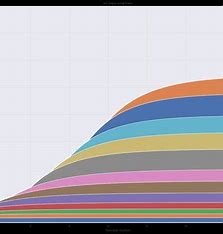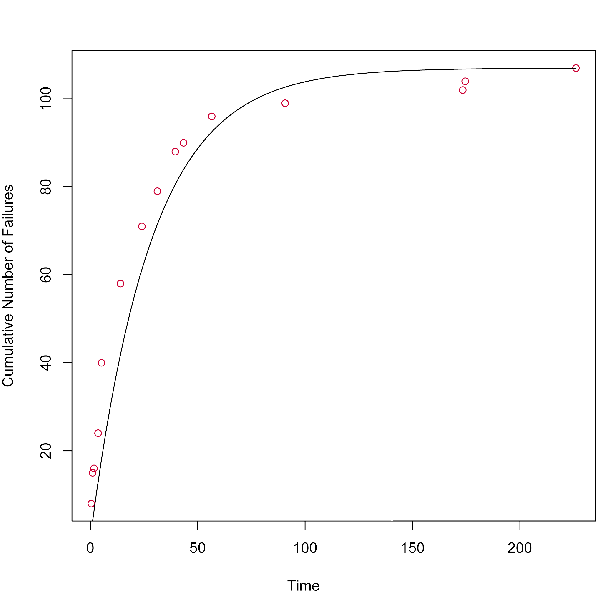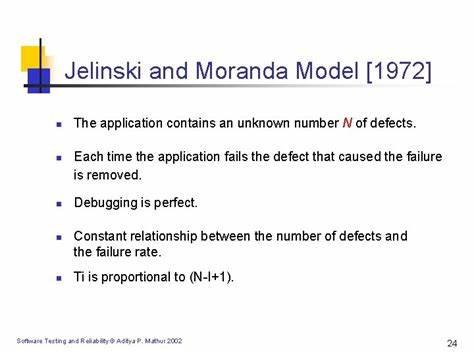Table of Contents
Introduction
The Jelinski & Moranda (J&M) model is a established and versatile method, for reliability modeling. It was developed during the 1960s and early 1970s rooted in classical reliability theory. Has since become widely used in software reliability modeling. The main focus of the J&M model is to analyze and predict how a software system behaves under levels of reliability and environmental circumstances. By evaluating the impact of components and environmental factors on reliability the J&M model empowers system designers and maintainers to make informed decisions regarding system enhancement and maintenance.
The J&M model is built upon three core principles; first giving importance to reliability as the characteristic when designing and analyzing software systems; second considering software systems as networks composed of interconnected components; third, expressing system reliability in terms of failure probability expected lifespan or both.

The Jelinski & Moranda (J&M) model is an extensive approach, to reliability modeling. It was developed during the 1960s and early 1970s grounded in classical reliability theory. Since then it has become widely adopted as a tool in software reliability modeling. The J&M model primarily focuses on understanding and predicting the behavior of software systems in levels of reliability and environmental conditions. By assessing the impact of components and environmental factors on reliability system designers and maintainers can make well informed decisions regarding system enhancement and maintenance.
The Jelinski & Moranda Model is a software reliability model that was proposed by M.A. Jelinski and P.A. Moranda in 1972. It is based on the assumption that the failure rate of a software system is proportional to the number of remaining faults in the software, and that the fault detection rate is constant over time. The model uses a non-homogeneous Poisson process to describe the failure behavior of the software, and it has two parameters: the initial number of faults and the failure detection rate

The model has the following equations:
|
The model can be used to predict the reliability of software systems, based on the observed failure data and the estimated parameters. The model can also be used to compute the additional number of failures and the additional testing time required to reach a certain failure intensity objective.

The model has some advantages, such as:
- It is simple, practical, and easy to understand.
- Its parameters clearly relate to the physical world.
- It can be used for accurate reliability prediction.
The model also has some limitations, such as:
- It assumes that all faults have the same failure intensity, which may not be realistic for complex software systems that have different types of faults with different severities and probabilities of occurrence.
- It assumes that the fault removal process is perfect and instantaneous, which may not be true for practical software development environments that have delays, errors, or rework in the fault correction activities.
- It assumes that the software system is tested under constant operational conditions, which may not be valid for software systems that have varying workloads, inputs, or configurations.
Key Characteristics;
Comprehensive Approach; The J&M model provides a systematic and adaptable approach to software system behavior under different levels of reliability and environmental conditions.
Analysis at Component Level; The J&M model allows for analyzing software systems as networks of interacting components offering an assessment, for evaluating system reliability.
Flexibility; The J&M model can be customized to fit the requirements of a software system by incorporating components and environmental factors.
The J&M model has the ability to predict the reliability of a system and understand its effects, in reliability and environmental conditions.
System designers and maintainers can rely on the J&M model as a tool for making decisions. It provides insights into improving system reliability and enhancing maintenance efforts.
In conclusion the J&M model is an achievement in software reliability modeling. It offers a systematic and adaptable approach, to comprehending and predicting the behavior of software systems across levels of reliability.
Conclusion
The J&M model stands as a significant achievement in software reliability modeling by providing a comprehensive, systematic and adaptable approach to understanding and predicting software system behavior under diverse levels of reliability and environmental conditions. Over time it has proven its value as an enduring tool, within the Software Development Life Cycle (SDLC).By highlighting the significance of dependability and describing system performance, in relation to the likelihood of failure and anticipated lifespan the J&M model plays a role, in software reliability modeling. Consequently the J&M model continues to offer perspectives on ways to bolster system reliability and enhance maintenance endeavors.
FAQS on jelinski & Moranda (J&M) Model
1. What is the Jelinski & Moranda (J&M) Model?
The J&M model is a known and widely used approach, for modeling reliability in software. It was developed in the 1960s and early 1970s. It is based on classical reliability theory.
2. How does the J&M model address software reliability?
The J&M model provides an adaptable approach to understanding. Predicting how software systems behave under different levels of reliability and environmental conditions. By evaluating the impact of components and environmental factors on reliability the J&M model helps system designers and maintainers make informed decisions about system improvements and maintenance.
3.What are the main features and characteristics of the J&M model?
Comprehensive Approach; The J&M model offers a systematic and adaptable method to comprehend and forecast how software systems behave in scenarios of reliability levels and environmental conditions.
Analysis, at Component Level; The J&M model allows for analyzing software systems as networks of interconnected components, which enables an evaluation of system reliability.
Flexibility; The J&M model can be customized to meet requirements of a software system by incorporating components and accounting for various environmental factors.
The J&M model has the ability to predict the reliability of a system and its effects, in reliability and environmental conditions.
For system designers and maintainers the J&M model provides support in decision making processes. It offers insights, on how to improve system reliability and enhance system maintenance efforts.